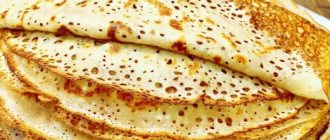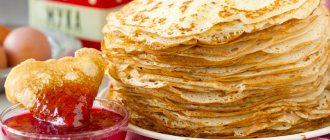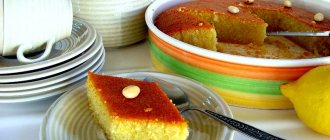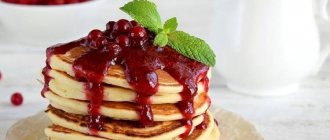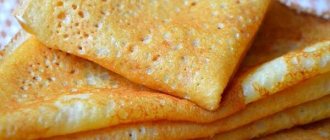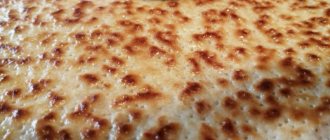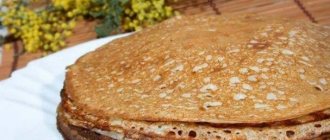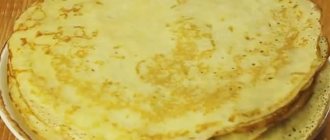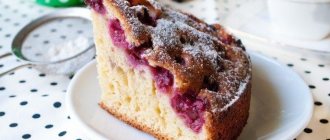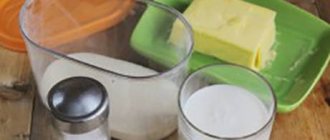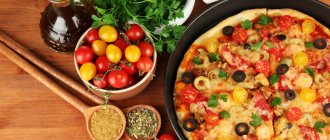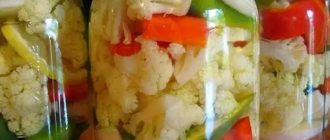This article will talk about the very concept of “small pancakes” and offer two culinary recipes. The differences between crepes and traditional Russian pancakes will also be determined.
According to grandma's recipe
Perhaps all the grandchildren loved to visit their grandmothers because of the thin pancakes with raspberry jam. Of course, the most important ingredient in this recipe is a lot of experience. After all, pancakes were baked almost every day in Soviet times.
Be sure to warm the milk for this recipe or use it at room temperature, not cold. Another important point is that the frying pan must be well heated. It is best to use cast iron cookware.
Mix all the ingredients; the dough should not be very liquid. Grandma's pancakes are not subtle, but they are always made with love. Place a piece of butter on top of the stack of pancakes.
Banana
Pancakes with fruit flavor
have gained particular popularity . And most of all recipes can be found with bananas . They are added both as a filling and in the dough itself.
To add bananas to the dough, you need to grate them and mix them with the pancake mixture. Add bananas to the dough as soon as possible, because they tend to turn black quickly. In this recipe you will need less flour. But add more oil to the pan because the pancakes will be thicker than usual. Make sure that they do not burn, but at the same time are well baked.
Hot chocolate works well as a sauce for banana pancakes. This would be the perfect breakfast or dessert option.
Features of the dish
Unfortunately, even experienced housewives believe that small pancakes are small pancakes. However, this is absolutely not true. This is a completely independent, delicious dish, which differs in many ways from pancakes.
Cupcakes, so beloved by Americans and Canadians, are often called pancakes, since they are small in size and it is quite natural that the name “small pancakes” is very applicable to them. But this is a misconception, because the cupcakes, despite the appropriate size, are of the wrong thickness. This product is something between pancakes and pancakes, so we can safely part with them.
The birthplace of pancakes is France, and they are called “crepes” there. Due to their low calorie content, they are extremely popular not only in France, but also in other European countries, especially in England and Germany. In the West, crepes are traditionally a dessert dish, so they have mainly a sweet filling and are served with chocolate, honey, and syrup. But this does not mean that crepes cannot have unsweetened fillings. You can try products with fish, meat, vegetable and even mushroom fillings. There is no limit to culinary imagination.
It's time to offer you a basic recipe for small pancakes (crepes). It must contain milk or fermented milk product.
Pancakes
These American pancakes are loved by many. In shape and size they are more reminiscent of our pancakes. They look very beautiful and, most importantly for the modern world, photogenic.
To get neat and fluffy pancakes , bake them in a frying pan without oil. To do this you will need non-stick cookware.
Beat the sugar and egg with a mixer into a fluffy foam. Then add all the other ingredients. Instead of baking soda, you can use baking powder. The most important thing is that after you mix everything, you need to add 2 tablespoons of vegetable oil directly to the dough.
American pancakes are served with various sauces. This version of pancakes was prepared for breakfast only in America and Canada, but not so long ago the dish spread to many other countries and became one of the popular breakfast options.
Cooking method
Let's begin the process of separating the whites from the yolks. Grind the yolks with granulated sugar. Pour in about two glasses of kefir and mix by hand until the required mass is obtained so that there are no lumps. Gently introduce flour, possibly with sifting, stirring all the time. Beat the protein mass with table salt (until a fluffy foam is obtained). Pour kefir, which we did not use, and pre-prepared yolks into the resulting mixture. Don't forget that pancakes are baked in a thin cast iron frying pan.
As flavorings for dessert pancakes, you can add vanilla essence, finely grated orange, lemon zest, liqueur, dessert wine or cognac.
Openwork
Openwork pancakes are most often baked for the festive table, because they look very beautiful. They can be used for both sweet and non-sweet fillings.
For example, openwork pancakes with red fish look very appetizing on a festive table. To make them just as unusual, use boiling water in the recipe. Once you have completely mixed all the ingredients, add ⅔ cup of boiling water to the dough. Mix well again and immediately start baking pancakes, no need to let the dough sit.
The pancakes come out with beautiful patterns and look artful. And the hostess with such a dish will appear before the guests as a real needlewoman.
Tender
To achieve maximum tenderness from the pancakes, you need to spend a little more time. But the result will fully justify the costs.
First you need to bake pancakes according to the classic recipe. Then roll each pancake into a tube and place them on a baking sheet. Melt the butter in a water bath and pour on top of each pancake.
Leave the dish to bake in the oven for 20 minutes. You can add filling to the tubes, for example, cottage cheese with raisins. Serve the tender pancakes hot with tea.
Custard
Choux pancake dough will help you get delicate pancakes with beautiful patterns.
Mix all ingredients. You can beat the sugar and eggs with a fork or use a whisk. Then pour in the milk and add the dry ingredients. Then pour in boiling water in a thin stream and stir without stopping. Be sure to add a little at a time so the eggs don't cook. Add oil and stir again.
Grease a frying pan with a piece of butter and heat it. Pour the dough into the center and spread around the entire perimeter of the pan. It is best to use a cast iron frying pan, but if this is not possible, a regular one with a non-stick coating will do.
With holes
In this recipe, the milk must be divided into two parts. Pour in the first part as in a regular recipe. Start the algorithm with the usual action - beat sugar, salt and eggs with a whisk. Add one part milk and dry ingredients. Then make sure there are no lumps, add the rest of the milk and vegetable oil.
As soon as you spread the dough over the hot pan, you will notice small holes begin to appear. Carefully flip the pancake over and bake the other side. Serve with any toppings. You can have it with sweet or not sweet. Wrap the filling in the pancakes with holes or simply pour syrup over them.
The most delicious, thin and delicate pancakes “with holes” made with milk - recipes
Pancakes with milk - a classic recipe
Each family has its own variation of the classic recipe, but we offer an interpretation that even a novice cook can do. The resulting milk pancakes are thin and elastic. They can be eaten “empty”, they are so tasty, or used for filled dishes.
We make a dry mixture of 125 grams of flour, a tablespoon of sugar and salt. This way the pancakes will be moderately sweet and rosy. Mix dry ingredients and sift. Separately beat 3 eggs, then add the beaten mass to the flour. Use a whisk or hand blender to thoroughly blend the mixture, taking your time.
Warm 250 milliliters of milk to room temperature. Pour half the milk into the egg-flour mixture. We carefully work with a whisk to prevent lumps. To make the pancakes “with holes,” separately melt a tablespoon of good butter. The oil must be natural, without vegetable fats, so margarine and spreads are unacceptable.
Combine the butter and the second half of the milk, slowly pouring into the dough. We need the consistency of a medium liquid, so we “test” the dough with a spoon: the mass should flow smoothly.
Bake the pancakes for a couple of minutes on each side. Serve with toppings and additions to taste.
Custard thin pancakes with milk
First, prepare the liquid part of the dough. Grind 3 large eggs with salt and granulated sugar. We adjust the amount of sugar depending on what fillings our pancakes will have. When the pancakes are planned to be sweet, a tablespoon is enough; if the filling is salty, reduce the sugar by half. We achieve complete dissolution of granulated sugar. Add milk (600 ml) to the mixture and mix.
Now we need hot water in the amount of 200 milliliters. Without stopping stirring, pour boiling water into the liquid mixture. You cannot pour boiling water in “one fell swoop”, otherwise the eggs will curdle. Only a thin stream and uniformity. It is very convenient to do this using a food processor or blender with a dough attachment.
It's time to add the sifted flour. We will need 300 grams. We stir until we are sure that there are no harmful lumps. Only then can you pour in 30 milliliters of vegetable oil and throw in a pinch of soda. Give the finished dough time to rest: at least half an hour. The consistency we need is moderately liquid. Bake pancakes in a hot frying pan and serve hot.
Thin yeast pancakes with milk
The bubbliest pancakes are those made with yeast. It is thanks to the fermentation of yeast that the texture of the dish turns out “spongy” and airy. Although working with yeast is off-putting for novice cooks, making it is no more difficult than classic yeast.
Grind two eggs with 100 grams of sugar and a pinch of salt. A larger amount of sugar than in conventional recipes is needed to make the yeast “play.” It is good to beat this mixture not by hand, but with a mixer, then a fluffy whitish foam will form and the sugar will dissolve faster. Separately, heat a glass of milk and water until warm, but not hot. Add liquid to the mixture and stir.
The yeast for this recipe is dry, fast-acting. We need 6 grams, which is about a level teaspoon. Our liquid will begin to foam, becoming covered in large bubbles.
Pour the liquid component of the dough into one and a half glasses (250 g) of sifted flour. After mixing well, leave the mass in a warm place at least 35 degrees for 60 minutes. The dough will increase in volume and become a little thicker. To give it the necessary consistency, add two tablespoons of vegetable oil right before baking the pancakes.
Information! Baking these pancakes is a pleasure. They turn out fluffy, but strong enough to withstand flipping. Beginning pancake bakers value yeast dough precisely for these properties.
Pancakes made with live yeast and milk
Another version of yeast dough for more experienced housewives. We use fresh live yeast, or pressed yeast. First, we make a dough: add a spoonful of sugar and a little salt to a glass of warm milk, and then dissolve 20 grams of live yeast in the liquid. Stir until dissolved, then add a glass of sifted flour and stir again.
The dough should stand for 40-60 minutes in a warm place without drafts. A good dough will double in volume.
Divide 4 eggs into yolks and whites. Beat the whites until fluffy with a teaspoon of salt. Grind the yolks with three tablespoons of sugar. Add the yolk mass and melted butter (4 tablespoons) into the dough. We dilute until smooth. The next step is flour. We need another glass so that the pancakes are thin and delicate. Having combined the flour with the dough, add the protein foam, stirring with confident movements from the bottom up.
The last stage is adding warm milk (750-800 milliliters). Let the dough rest for half an hour, and only then start baking.
Pancakes with milk in a bottle
An ideal recipe for people who don't want to spend a lot of time baking pancakes and haven't yet mastered the art of mixing batter without lumps. We need a two liter plastic bottle. Using a funnel, break 2 eggs directly into the bottle, add sugar (2 teaspoons), salt (1 tsp), and a pinch of soda. Helpful tip: Add the dry ingredients first, then add the eggs. Stir the egg mixture vigorously, making sure to close the lid.
Second stage: add 150 grams of flour and add vegetable oil (20 ml). Shake thoroughly again. The milk is poured in last. We need 600 milliliters. Shake the closed bottle vigorously to ensure that no lumps form.
Important! When baking, pour the batter into the pan directly from the bottle, frying the pancakes for two minutes on each side.
Pancakes made with cornmeal milk
Beat 300 milliliters of milk with three eggs until a fluffy foam forms. Separately mix premium corn flour (300 g), 50 grams of sugar and a pinch of salt, sifting them together.
Add the milk mixture to the flour mixture, stirring until the lumps disappear completely. Add vegetable oil (3 tablespoons) and let the dough “rest” for half an hour, and then bake bright and fragrant corn pancakes.
Healthy pancakes made from rye flour with milk
As in the previous recipe, mix rye flour (200 g), salt and 50 grams of sugar together, and only then sift the mixture, saturating it with air. Then pour a glass of warm milk and one egg into the dry ingredient. Whisk until smooth. At this stage, add half a teaspoon of soda to the mixture and quench it with lemon juice or vinegar directly in the dough. Mix 300 milliliters of warm milk and 2 tablespoons of vegetable oil, add to the dough and achieve a homogeneous liquid consistency.
Before baking pancakes, leave the dough warm for 20 minutes.
Traditional pancakes made with buckwheat flour and milk
Mix 100 grams of buckwheat and wheat flour, sift. Separately, beat 375 milliliters of warm milk, half a teaspoon each of salt and sugar, and two eggs. We need a foamy bulk mass.
Pour the liquid component into the mixture of two types of flour in a thin stream. There should be no lumps in the pancake batter. Add vegetable oil to the dough at the very end, in the amount of two tablespoons. Mix until a homogeneous, smooth consistency. We bake like regular pancakes.
Openwork cheese pancakes with milk
Beat one and a half glasses of warm milk together with two chicken eggs until foam forms. Be sure to add a teaspoon of sugar and salt to the mixture. Sift a glass of flour with a teaspoon of baking powder through a fine sieve. Add the liquid part to the dry part, stirring continuously.
Prepare the cheese filling: three 150 grams of cheese on a fine grater. It is better to take a type of cheese that melts well and has a rich aroma. Finely chop a bunch of dill. Add this mixture to the dough, then pour in two more tablespoons of vegetable oil and bring to a liquid consistency convenient for baking.
It makes an excellent snack - delicious cheese pancakes.
Sweet chocolate pancakes with milk
Mix 2 cups of flour and cocoa powder (2 tbsp), add a bag of baking powder, sift. Grind 3 eggs with sugar (3 tbsp) and salt, then add a glass of warm milk into the mixture, bringing to a fluffy foam.
We combine the liquid and dry phases of the dough. If lumps appear at this stage, don’t worry. We take another glass of milk and gradually pour it into the dough in small portions, controlling the thickness and texture of the mixture. We need a condition like liquid sour cream. Bake pancakes in a frying pan greased with a small amount of vegetable oil. They can be served as a separate dish or filled with cream cheese or strawberries.
Velvet
To make pancakes velvety, it is impossible to do without a mixer. Beat the eggs with sugar into a fluffy foam and carefully pour in one part of the milk. Then add flour little by little and mix thoroughly.
When all the ingredients are in the bowl, mix everything again using a mixer. You will get a fluffy dough. There is no need to insist on it; the dough may settle over time.
Bake velvety pancakes in a hot frying pan. Grease each pancake with butter.
Pancakes with milk and water - a recipe for thin pancakes
We will prepare custard pancakes with milk and water, the recipe is quite simple and the pancakes are prepared quickly and easily.
Components:
- Milk—0.5l
- Boiling water - 1 glass
- Flour-300g
- Egg-3pcs
- Sugar-2 tbsp. spoons
- Vegetable oil-2 tbsp. spoons
- Butter-10g
- Salt - 1 teaspoon
Cooking instructions:
- Sift the flour into a bowl, add sugar and salt and mix.
- Heat the milk to body temperature (not higher than 40g), pour a small amount into the flour so that the milk envelops the flour and the flour does not fly around the kitchen.
- Using a mixer at low speed, stir the flour and gradually add the milk.
- Break the eggs into the mixture and mix in a mixer.
- Boil water and quickly pour into the dough, stir and cover the bowl with a cloth or towel, leave for 30-40 minutes to infuse. There is no need to worry that the eggs will cook in boiling water; on the contrary, the dough will turn out airy and fluffy.
- When the dough has rested, pour in vegetable oil (you can use melted butter) and mix.
- Heat the frying pan well, grease it with vegetable oil, pour the dough into the pan with a ladle so that the bottom is hidden and fry over medium heat until golden brown. Transfer the finished pancake to a plate and grease with butter.
Thin
People are divided into two types: those who love thin pancakes and those who love thick ones. Our grandmothers baked thick pancakes; you could fill up with 3-5 pancakes. In modern cafes and restaurants they prefer to serve thin pancakes. This option is great for snacks, especially not sweet ones.
To make the pancakes as thin as possible, add water to them. You can use not only boiling water, but regular boiled water at room temperature. The dough will be more liquid and the pancakes will become thinner.
But the baking process itself will become more difficult. Therefore, you need to carefully ensure that the pancake does not burn. Turn over as soon as the edges puff up a little and turn brown. The most delicious are thin pancakes with a delicious filling, for example, red caviar.
How to make delicious dough for thin pancakes using milk
Before you start learning recipes, you need to learn how to make good dough. Otherwise, contrary to popular wisdom, all the pancakes will end up lumpy, not just the first one. The ideal consistency is achieved using a few simple secrets:
- First of all, flour. It must be of the highest quality, no matter what type you take: wheat, rye, corn. Be sure to sift the flour through a fine sieve, saturating it with oxygen. This will help the dough become softer, and the finished product, despite its subtlety, will have an incredibly delicate taste.
- All additives like sugar and salt must be perfectly dissolved in the liquid part of the dough. The absence of grains also has a positive effect on the texture of the pancakes. Undissolved sugar can also burn in the pan.
- Pay attention to the eggs you use for cooking. They should be at room temperature, so we recommend keeping them outside of the refrigerator for a few hours. Another secret that will help: separate the yolk from the white and beat them separately. The yolks are ground with sugar, and the whites are beaten until fluffy. They should be added last, after the flour, just before baking.
- Inexperienced cooks make a common mistake by pouring flour into the liquid part of the dough. This leads to the formation of unpleasant lumps. To avoid this, sift the flour and then pour in the liquid ingredients. Try to adjust the thickness of the stream without pouring everything in one fell swoop. It's best to do this slowly while stirring the dough.
Of course, for people who have been baking pancakes for many years, the process does not cause any difficulties. Skill comes with experience, and they do not need to separate the eggs or adhere to special techniques. But if this is your first time trying to cook such a dish, our secrets will help you cope with the cooking. And then, as in the saying, only the first pancake will be lumpy.
